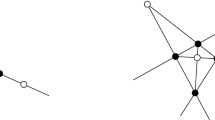Abstract
One of the De Bruijn-Erdős theorems deals with finite hypergraphs where every two vertices belong to precisely one hyperedge. It asserts that, except in the perverse case where a single hyperedge equals the whole vertex set, the number of hyperedges is at least the number of vertices and the two numbers are equal if and only if the hypergraph belongs to one of simply described families, near-pencils and finite projective planes. Chen and Chvátal proposed to define the line uv in a 3-uniform hypergraph as the set of vertices that consists of u, v, and all w such that {u;v;w} is a hyperedge. With this definition, the De Bruijn-Erdős theorem is easily seen to be equivalent to the following statement: If no four vertices in a 3-uniform hypergraph carry two or three hyperedges, then, except in the perverse case where one of the lines equals the whole vertex set, the number of lines is at least the number of vertices and the two numbers are equal if and only if the hypergraph belongs to one of two simply described families. Our main result generalizes this statement by allowing any four vertices to carry three hyperedges (but keeping two forbidden): the conclusion remains the same except that a third simply described family, complements of Steiner triple systems, appears in the extremal case.
Similar content being viewed by others
References
N. Alon, K.E. Mellinger, D. Mubayi, J. Verstraëte: The de Bruijn-Erdős theorem for hypergraphs, arXiv:1007.4150v1 [math.CO].
C. Berge: Graphes et hypergraphes. Monographies Universitaires de Mathématiques, No. 37. Dunod, Paris, 1970.
L. Babai: On the nonuniform Fisher inequality, Discrete Mathematics 66 (1987), 303–307.
L. M. Blumenthal: Theory and Applications of Distance Geometry. Oxford University Press, Oxford, 1953.
T. C. Bose: A note on Fisher’s inequality for balanced incomplete block designs, Ann. Math. Statistics 20 (1949), 619–620.
H. Busemann: The Geometry of Geodesics. Academic Press, New York, 1955.
X. Chen: The Sylvester-Chvátal theorem, Discrete & Computational Geometry 35 (2006), 193–199.
X. Chen and V. Chvátal: Problems related to a de Bruijn-Erdős theorem, Discrete Applied Mathematics 156 (2008), 2101–2108.
E. Chiniforooshan and V. Chvátal: A De Bruijn-Erdős theorem and metric spaces, Discrete Mathematics & Theoretical Computer Science 13 (2011), 67–74.
A. Chowdhury: On a conjecture of Frankl and Füredi, The Electronic Journal of Combinatorics 18 (2011), Paper 56.
J. A. Bondy and U. S. R. Murty: Graph theory. Springer, New York, 2008.
V. Chvátal: Sylvester-Gallai theorem and metric betweenness, Discrete & Computational Geometry 31 (2004), 175–195.
N.G. De Bruijn and P. Erdős: On a combinatorial problem, Indagationes Mathematicae 10 (1948), 421–423.
N. G. De Bruijn and P. Erdős: A colour problem for infinite graphs and a problem in the theory of relations, Indagationes Mathematicae 13 (1951), 369–373.
A. A. Dovgoshei and D. V. Dordovskii: Betweenness relation and isometric imbeddings of metric spaces, Ukrainian Mathematical Journal 61 (2009), 1556–1567.
P. Frankl and Z. Füredi: Families of finite sets with missing intersections, Finite and infinite sets, (Eger, 1981), Colloq. Math. Soc. János Bolyai 37, North-Holland, Amsterdam, 1984, 305–318
P. Frankl and Z. Füredi: A sharpening of Fisher’s inequality Discrete Mathematics 90 (1991), 103–107.
D. J. Houck and M.E. Paul: On a theorem of de Bruijn and Erdős, Linear Algebra Appl. 23 (1979), 157–165.
K. Menger: Untersuchungen uber allgemeine metrik, Mathematische Annalen 100 (1928), 75–163.
G.V. Ramanan: Proof of a conjecture of Frankl and Füredi, Journal of Combinatorial Theory Series A 79 (1997), 53–67.
B. Richmond and T. Richmond: Metric spaces in which all triangles are degenerate, American Mathematical Monthly 104 (1997), 713–719.
H. J. Ryser: An extension of a theorem of de Bruijn and Erdős on combinatorial designs, Journal of Algebra 10 (1968), 246–261.
D. Seinsche: On a property of the class of n-colorable graphs, Journal of Combinatorial Theory Series B 16 (1974), 191–193.
H. S. Snevily: On generalizations of the de Bruijn-Erdős theorem, Journal of Combinatorial Theory Series A 68 (1994), 232–238.
L. E. Varga: Geometric matrices and an inequality for (0,1)-matrices, Discrete Mathematics 82 (1990), 303–315.
Author information
Authors and Affiliations
Corresponding author
Additional information
Partially supported by NSF grants DMS-1001091 and IIS-1117631
Canada Research Chair in Discrete Mathematics



